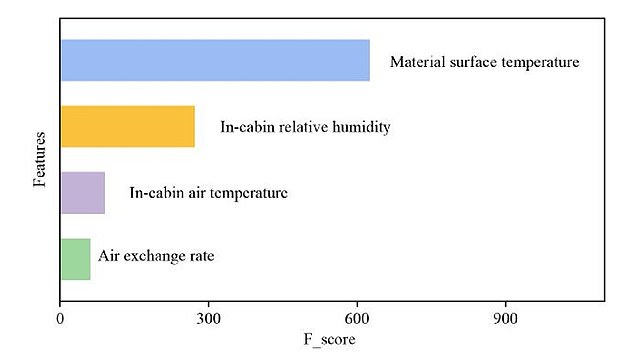Toxic warning issued to millions of Americans driving in hot weather this summer — how do you know if you’re at risk?
New research shows that the interior of your car could be releasing a flood of toxins into your lungs on hot days.
Formaldehyde and other toxic chemicals used in some of our favorite parts of a new car, from soft seats to plush leather upholstery, contain formaldehyde, a chemical linked to cancer, and other volatile organic compounds (VOCs).
When cars heat up to about 70 to 110 degrees, those chemicals turn into a poisonous gas that enters the body through the nostrils.
They cause irritation of the mucous membranes, headache, nausea and dizziness.
Inhaling volatile organic compounds causes headaches, nausea and dizziness in the short term. In the long term it increases the risk of cancer, cognitive problems and organ damage.

The graph shows the most influential factors in a car that increase the emission of volatile organic compounds such as formaldehyde
Long-term exposure to formaldehyde and the related acetaldehyde and hexaldehyde has been linked to kidney damage, memory loss, cognitive problems, cancer, particularly blood cancer, and heart disease.
Ventilation can drastically reduce these risks, which is why researchers advise against sitting in a hot car during the warmer months without the air conditioning on or the windows open.
Researchers from the Beijing Institute of Technology and Peking University have measured how hot weather can affect the emission of hazardous chemicals in a car cabin.
With no one in the car and the engine off, they measured how much air flowed through the car.
They placed dry ice on the back seat, which created carbon dioxide, allowing them to assess how efficiently the air in a room is refreshed.
CO2 acts as a ‘tracer gas’, meaning it is introduced into the space in a controlled manner to track how the air is being replaced.
By monitoring the concentration of this gas over time, they can deduce how quickly fresh air is replacing old air.
They tested 12 volatile chemicals, such as formaldehyde, benzene, O-xylene and acetaldehyde, under different weather conditions and how they affected the interior of the car, including sunny, cloudy and rainy days.
They then discovered that the temperature inside the car could get very high, especially on sunny days. The temperature ranged from about 24 to over 63 degrees Celsius, while the outside temperature ranged from 25 to 46 degrees Celsius.
Formaldehyde had the highest concentration of all VOCs measured as temperatures rose, exceeding the Chinese national standard of 100 micrograms per cubic meter of air.
Acetaldehyde concentrations ranged from 30 to 100 micrograms per cubic meter of air.
By measuring different outside temperatures, researchers were able to simulate different realistic weather scenarios and better understand how temperature inside the car affects VOC emissions.
As seats and other materials in the car warmed up, they tended to increase the levels of volatile compounds,

Exposure to VOCs can irritate children’s airways and cause asthma. They can also lead to cognitive development delays and chronic health problems, including respiratory disease.
The temperature range also allowed them to evaluate the performance of the car’s ventilation system under different conditions.
Certain chemicals are found in materials used to produce seat covers, plastic dashboards, brake pedals and steering wheels.
To reduce the risk of exposure to these chemicals, people should keep their windows open or turn on the air conditioning in their cars on a hot day.
The latest study, published in the journal PNAS nexusis not the first to research the volatile organic compounds emitted by cars.
In 2001, Australian researchers discovered that simply sitting in a new car exposes the driver to toxic emissions several levels higher than what health officials consider safe.
Research leader Steve Brown said: ‘We found that new car interiors have much higher VOC levels than any of the buildings we examined.
‘Ultimately, we need cars with interior materials that produce fewer emissions.’
All cars use similar materials for their seats and other cabin components. That means they all emit some amount of volatile chemicals. But what those are depends on car-specific factors, from the material used for the seats to the fuel they require.
Because electric cars have zero fuel emissions and less heat is generated by the engine, the chemical emission levels of a Tesla may be lower than those of a gas-guzzling SUV.
Previous studies have shown that the provinces most sensitive to the effects of a warming climate including those in UtahColorado and California, all of which have seen exceptionally high average summer temperatures than in previous decades.
